人教新课标英语选修十Unit 5 Enjoying novels (全单元教案)
文档属性
| 名称 | 人教新课标英语选修十Unit 5 Enjoying novels (全单元教案) | 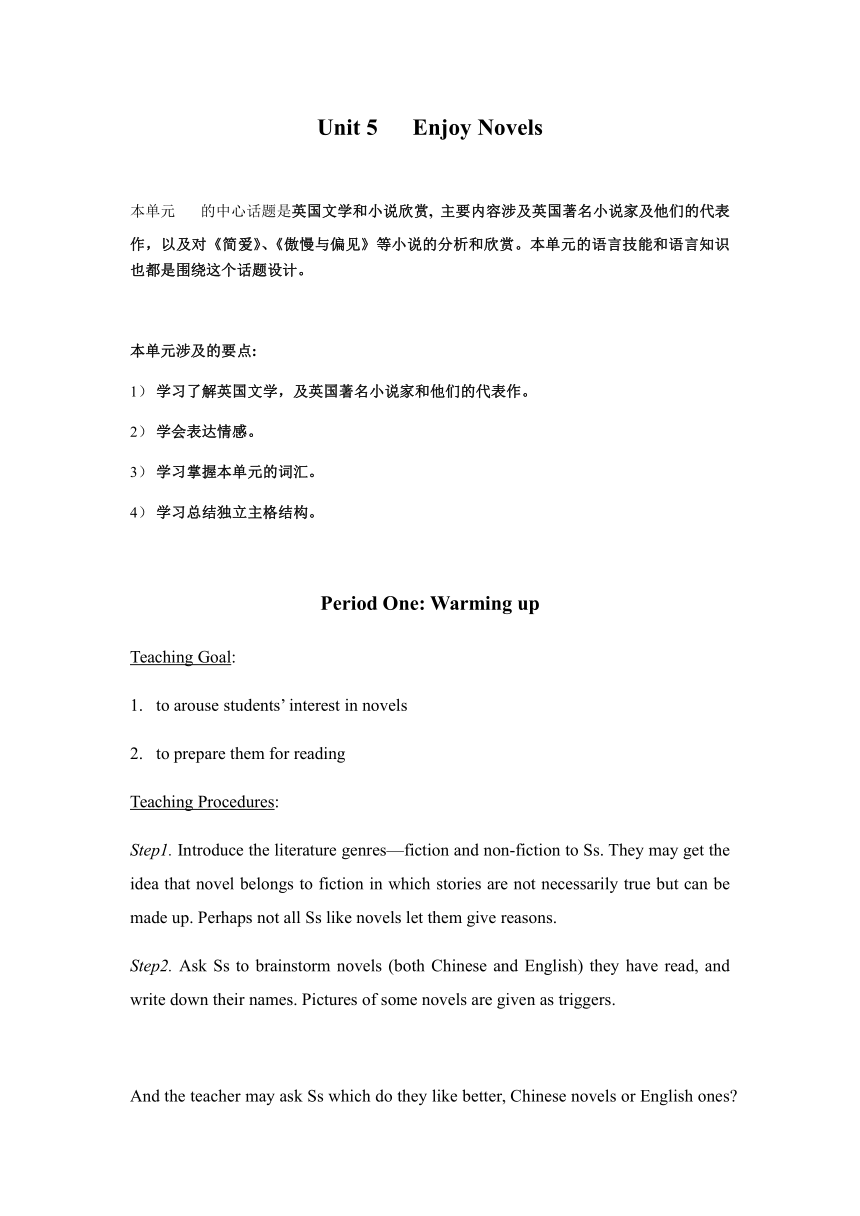 | |
| 格式 | zip | ||
| 文件大小 | 99.5KB | ||
| 资源类型 | 教案 | ||
| 版本资源 | 人教版(新课程标准) | ||
| 科目 | 英语 | ||
| 更新时间 | 2019-12-08 09:57:17 | ||
图片预览

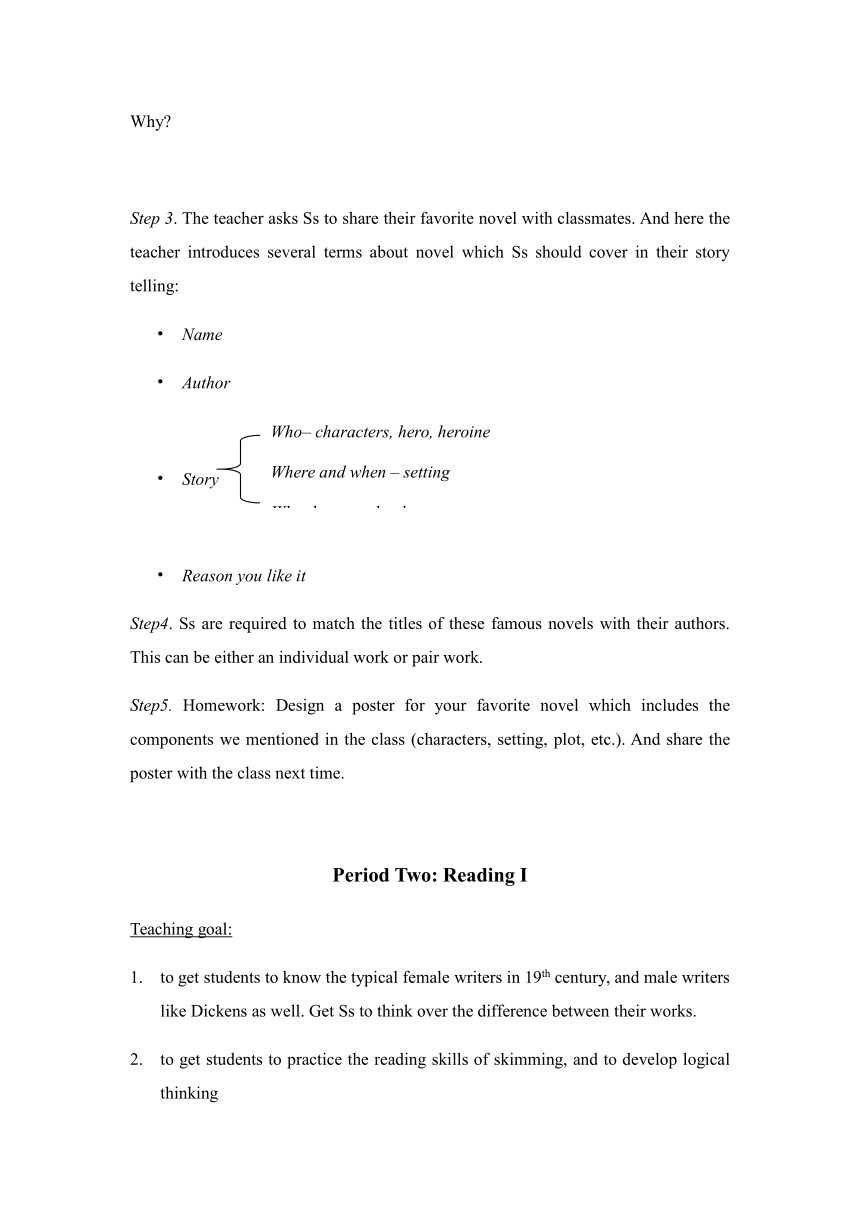
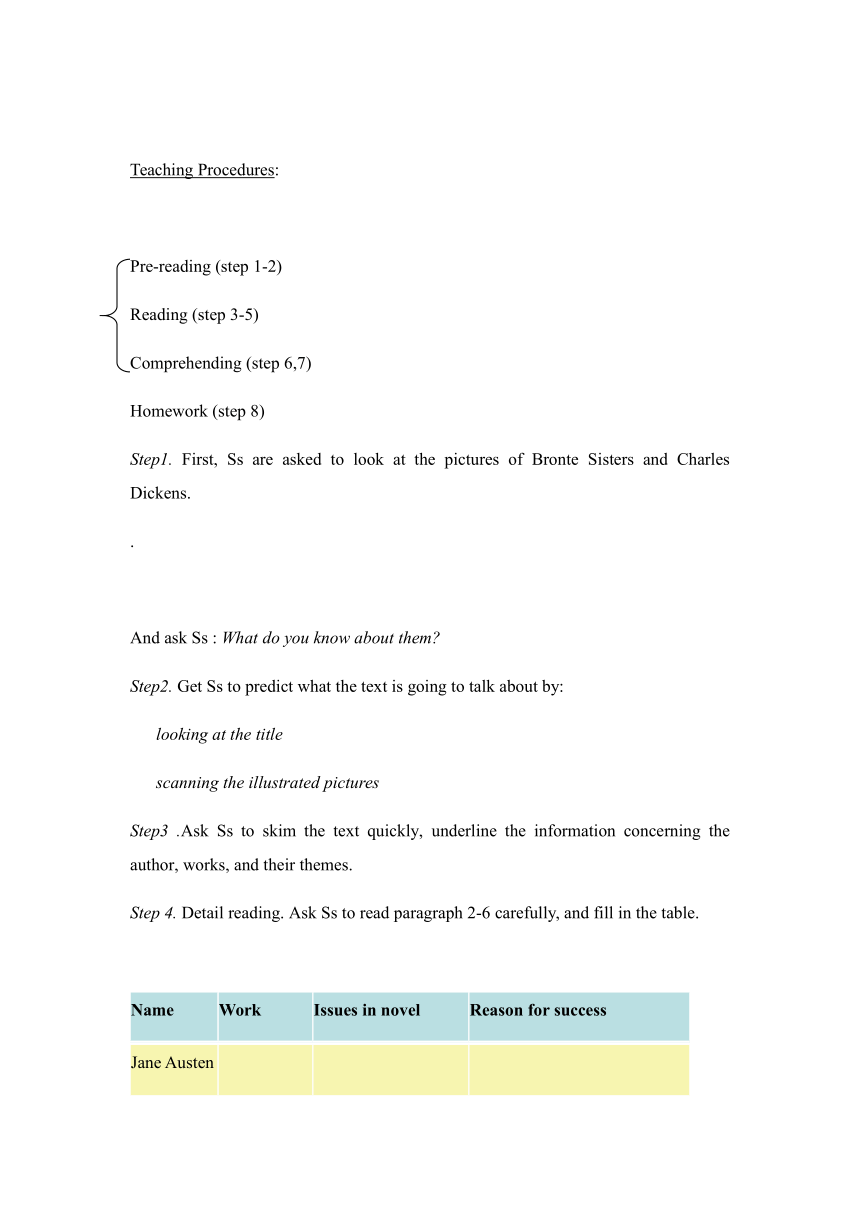
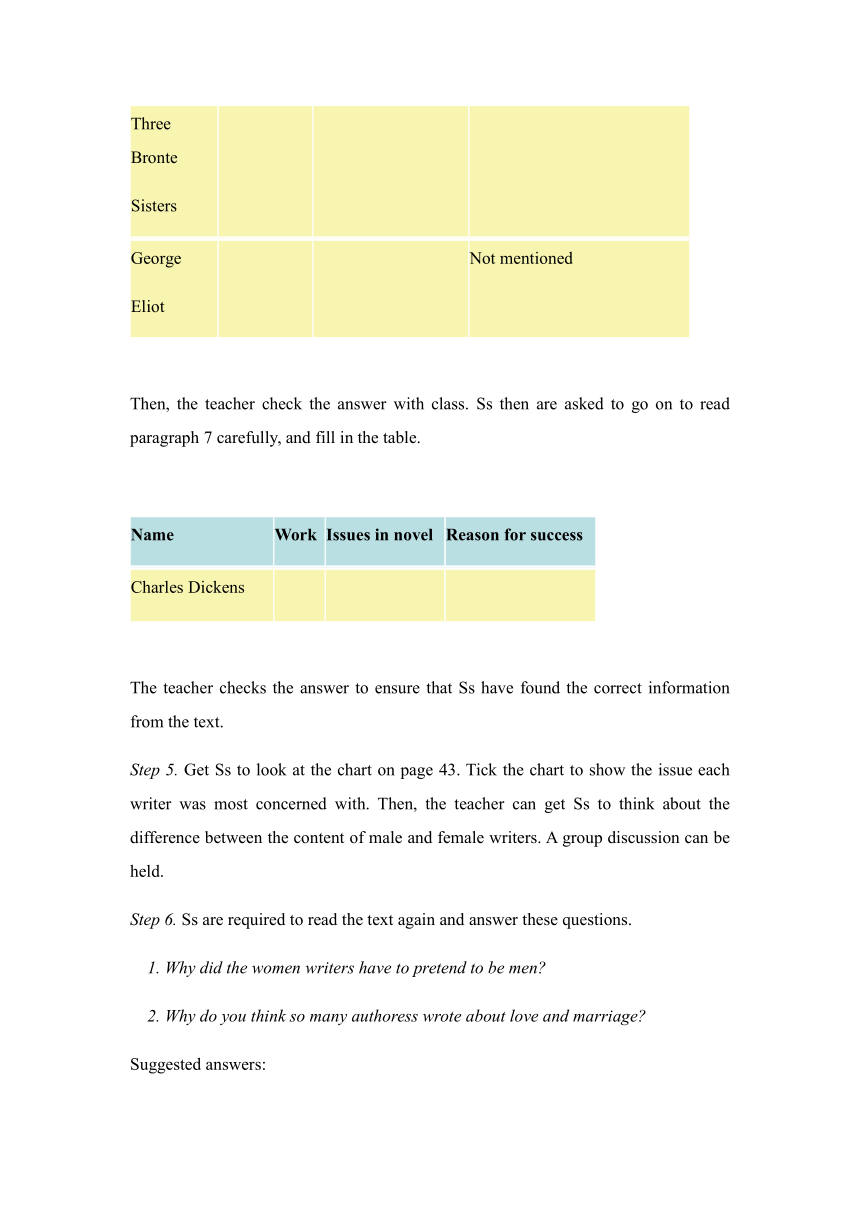
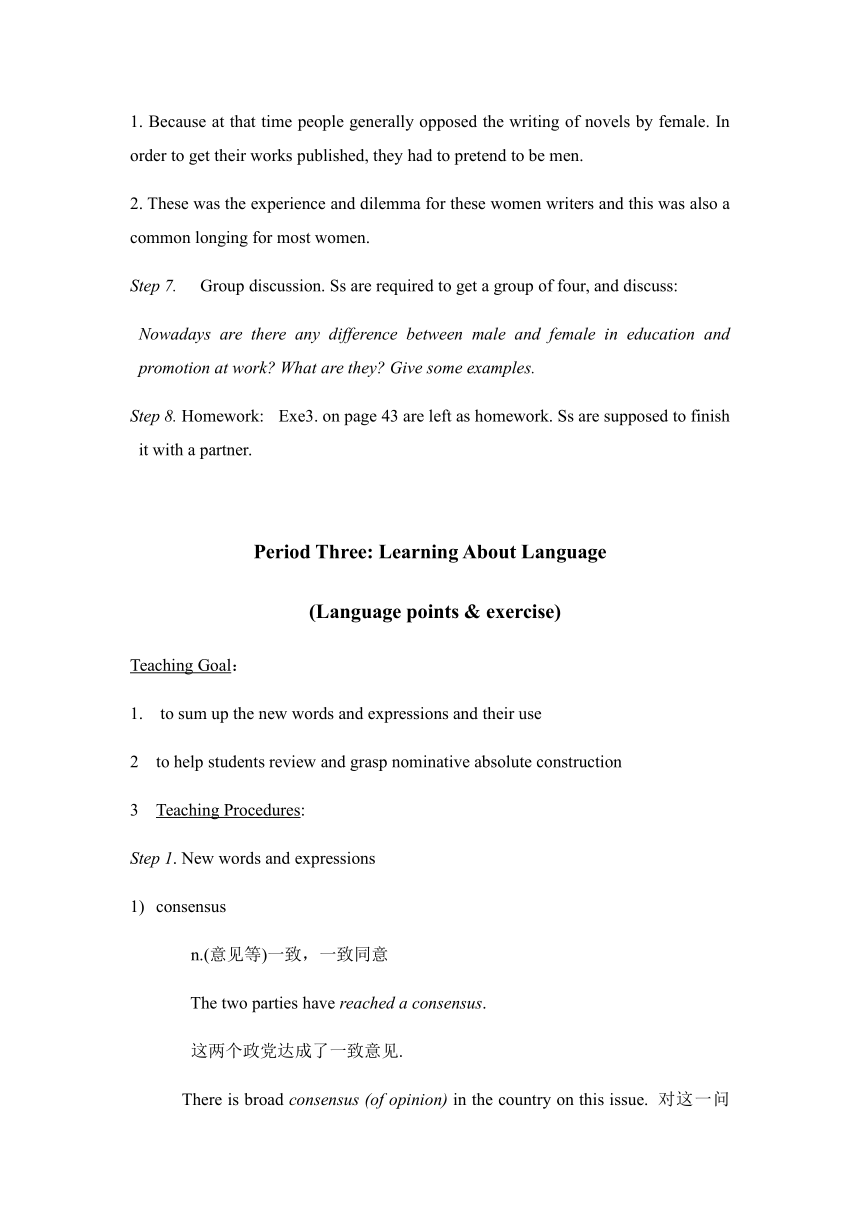
文档简介
Unit 5 Enjoy Novels
本单元的中心话题是英国文学和小说欣赏, 主要内容涉及英国著名小说家及他们的代表作,以及对《简爱》、《傲慢与偏见》等小说的分析和欣赏。本单元的语言技能和语言知识也都是围绕这个话题设计。
本单元涉及的要点:
1) 学习了解英国文学,及英国著名小说家和他们的代表作。
2) 学会表达情感。
3) 学习掌握本单元的词汇。
4) 学习总结独立主格结构。
Period One: Warming up
Teaching Goal:
1. to arouse students’ interest in novels
2. to prepare them for reading
Teaching Procedures:
Step1. Introduce the literature genres—fiction and non-fiction to Ss. They may get the idea that novel belongs to fiction in which stories are not necessarily true but can be made up. Perhaps not all Ss like novels let them give reasons.
Step2. Ask Ss to brainstorm novels (both Chinese and English) they have read, and write down their names. Pictures of some novels are given as triggers.
And the teacher may ask Ss which do they like better, Chinese novels or English ones? Why?
Step 3. The teacher asks Ss to share their favorite novel with classmates. And here the teacher introduces several terms about novel which Ss should cover in their story telling:
? Name
? Author
? Story
? Reason you like it
Step4. Ss are required to match the titles of these famous novels with their authors. This can be either an individual work or pair work.
Step5. Homework: Design a poster for your favorite novel which includes the components we mentioned in the class (characters, setting, plot, etc.). And share the poster with the class next time.
Period Two: Reading I
Teaching goal:
1. to get students to know the typical female writers in 19th century, and male writers like Dickens as well. Get Ss to think over the difference between their works.
2. to get students to practice the reading skills of skimming, and to develop logical thinking
Teaching Procedures:
Pre-reading (step 1-2)
Reading (step 3-5)
Comprehending (step 6,7)
Homework (step 8)
Step1. First, Ss are asked to look at the pictures of Bronte Sisters and Charles Dickens.
.
And ask Ss : What do you know about them?
Step2. Get Ss to predict what the text is going to talk about by:
looking at the title
scanning the illustrated pictures
Step3 .Ask Ss to skim the text quickly, underline the information concerning the author, works, and their themes.
Step 4. Detail reading. Ask Ss to read paragraph 2-6 carefully, and fill in the table.
Name Work Issues in novel Reason for success
Jane Austen ? ? ?
Three BronteSisters ? ? ?
George Eliot ? ? Not mentioned
Then, the teacher check the answer with class. Ss then are asked to go on to read paragraph 7 carefully, and fill in the table.
Name Work Issues in novel Reason for success
Charles Dickens ? ? ?
The teacher checks the answer to ensure that Ss have found the correct information from the text.
Step 5. Get Ss to look at the chart on page 43. Tick the chart to show the issue each writer was most concerned with. Then, the teacher can get Ss to think about the difference between the content of male and female writers. A group discussion can be held.
Step 6. Ss are required to read the text again and answer these questions.
1. Why did the women writers have to pretend to be men?
2. Why do you think so many authoress wrote about love and marriage?
Suggested answers:
1. Because at that time people generally opposed the writing of novels by female. In order to get their works published, they had to pretend to be men.
2. These was the experience and dilemma for these women writers and this was also a common longing for most women.
Step 7. Group discussion. Ss are required to get a group of four, and discuss:
Nowadays are there any difference between male and female in education and promotion at work? What are they? Give some examples.
Step 8. Homework: Exe3. on page 43 are left as homework. Ss are supposed to finish it with a partner.
Period Three: Learning About Language
(Language points & exercise)
Teaching Goal:
1. to sum up the new words and expressions and their use
2 to help students review and grasp nominative absolute construction
3 Teaching Procedures:
Step 1. New words and expressions
1) consensus ?
n.(意见等)一致,一致同意
The two parties have reached a consensus.
这两个政党达成了一致意见.
There is broad consensus (of opinion) in the country on this issue. 对这一问题举国上下(舆论)普遍一致.
2) equality ?
n.相等,相同,平等
The country's constitution embodies the ideals of freedom and equality.
这个国家的宪法体现了自由和平等的理想。
equality between men and women
the right to equality of opportunity
3) in force ?
有效,生效,在实施中
The new safety regulations are now in force.
新的安全规则现已生效
Many old rules are not in force any more.
许多旧的制度都已经失效
4) contradiction ?
n.矛盾,不一致;否认,反驳
Your behavior is in direct contradiction to the principles you claim to have.
There seems to be a contradiction between her words and actions.
她的言行似乎不一致。
5) get round
设法逃避,躲开; 说服
There are always some people trying to get round the tax law.
总有人想方设法逃税。
I got round my father to lend me his car.
我说服了父亲借车给我。
6) explicit ?
a.详述的,明确的;毫不隐瞒的,露骨的
He gave me explicit directions on how to get there.
他清清楚楚地告诉我怎样到达那里.
Zhou was far too intelligent to make the Chinese dilemma explicit.
周氏何等聪明,岂能把中国的困境暴露于人前。
Step 2. Exercises on new word and expressions.
1) Read the words and phrases in the box, and select five to complete the Read the words and phrases in the box, and select five to complete the sentences.
?
? The law still stands _______.
? Women have yet to achieve full _______ with men in the workplace.
? That's a flat ____________of what you said before.
? They gave ________ reasons for leaving.
? In fact, your ________ words amount to a refusal.
2) Do exe 2 on page 44.
Step 3. 独立主格结构
1.构成:
? 名词(代词)+非限定性结构(现在分词、过去分词、不定式)
? 名词(代词)+形容词(或词组)
? 名词(代词)+副词(或词组)
? 名词(代词)+介词短语
2. 意义与用法:
名词或代词与后面的部分构成逻辑上的主谓关系,但结构上独立。一般充当状语,修饰整个句子,可置于主句前、主句末,或插入主句中。如:
There being no rain, the crops died.
He came into room, his years red with cold.
3. 区分:
? 现在分词表示主动,逻辑主语发出动作
? 过去分词表示被动,逻辑主语承受动作
? 分词的完成式表示的动作在谓语动作之前发生
Step 4. Exercises on nominative absolute constructions.
1) Read the sentences at the bottom of page 44, and identify and analyze the nominative absolute construction.
? Weather permitting,…
? The old one being stained with dust,…
? …, with two bodyguards following them.
? The burglars having been caught by the police,…
2) Choose the best answer.
1) The murderer was brought in, with his hands _____ behind his back.
A. being tied
B. having tied
C. to be tied
D. tied
2) All tasks ____ ahead of time, they decided to go on a holiday for a week.
A. been completed
B. having been completed
C. were completed
D. had been completed
3) We left the meeting, there obviously ____ no point in staying.
A. were
B. being
C. to be
D. having
Step 5. Homework: Do exe4. on page 45 with your group members.
Period Four: Reading II
Teaching Goal:
1. to get Ss to read and feel the famous novel extract
2. to make Ss know ways of expressions of emotion.
Teaching Procedures:
Step1. Warm up discussion.
Ss are asked to discuss :
Do you know what the word “proposal” means?
The picture is given to help Ss form an idea. And the teacher can introduce the use of the word: One may accept or refuse the proposal.
And, further, Ss can discuss: Have you seen or heard any marriage proposal?
What’s the ideal proposal you can imagine? Describe it to your classmates.
Step 2. Ss are asked to look at the questions first. With the questions below, look at the proposal from Pride and Prejudice.
? Why did Elizabeth refuse Mr Darcy?
? Why was Mr Darcy sure that she would accept him?
Suggested answer:
? Elizabeth refused Mr Darcy because she didn’t like or love him.
? Mr Darcy was sure that she would accept him because he was so rich.
Step 3. Detail reading. Ss are required to read the text carefully and fill in the table.
Reasons for marrying Darcy Reasons against marrying Darcy
1234 1234
Step 4. Ss are asked to make a dialogue between Elizabeth and her father concerning why Elizabeth cannot marry Darcy and what her mother will say.
Useful expressions are provided in case Ss should use them in the dialogue.
Step5. Homework : Practice the dialogue you have made with your partner. Carry it out as role play next time.
Period Five: Using Language
Teaching Goal:
1) To further develop the skills of listening and discussing.
2) To get Ss to learn how to write one’s opinions.
Teaching Procedures:
Step1. A group discussion part is introduced as warming up. Ss are supposed to discusss:
? Do you judge people by their appearance?
? Have you ever made a mistake in judging people? What made you change your mind later?
Step2. Listen to the tape and do exe 2 on page 46.
Step3. Ask Ss to read the question first, and listen to it again in detail, and answer the questions.
? Did Darcy really dislike Elizabeth?
? Why did Elizabeth dislike Darcy?
? Who realized his/her mistake first?
? What made Elizabeth change her mind?
? Who do you sympathize with more: Darcy or Elizabeth? Why?
? What can you learn from this romance?
Step4. Pair Discussion. Ss then are asked to express their opinions in pairs.
What kind of person make a good friend? Put the qualities in order and give your reason.
* clothes the person wears
* the person’s accent
* how friendly he/she is
* what the person says
* the person’s social status
* how he/she behaves
Step5 . At this stage, Ss are asked to work in group of the same gender, and discuss what might happen in the situations on page 49.
Step 6. Prepare for writing.
1) Discuss your opinion of Darcy or Elizabeth with your partner. Was their behavior right or wrong? Why do you think so?
2) Write down your ideas and put them into an order that seems sensible
Step 7. Writing. Ss may start writing following the structure:
Step 8. Homework: Finish writing work and do the peer assessment.
Who– characters, hero, heroine
Where and when – setting
What happened– plot
The problem to be solved– conflict
